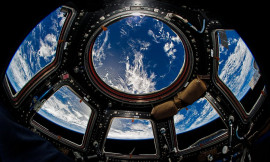
Thousands of professional and amateur photographers from around the world entered the competition which is in its eight year, and the biggest of its kind. Over 4,500 entries were received from 80 countries across the globe and 31 prize winners were announced at an award ceremony in London.
Here we look at some of this year's winners.
 As the moon "grazes" by the sun during a solar eclipse, the rugged lunar limb topography allows beads of sunlight to shine through in some places, and not in others. The series of photos of the total solar eclipse are stacked, showing the full progression of a solar eclipse from Luwuk, Indonesia. Winner of "Our Sun" category and Overall Winner. PHOTO: YU JUN
As the moon "grazes" by the sun during a solar eclipse, the rugged lunar limb topography allows beads of sunlight to shine through in some places, and not in others. The series of photos of the total solar eclipse are stacked, showing the full progression of a solar eclipse from Luwuk, Indonesia. Winner of "Our Sun" category and Overall Winner. PHOTO: YU JUN In Hong Kong, the urban streets and buildings are dotted with countless light pipes and huge neon signs which cause serious light pollution. When this city falls asleep at night, only a few stars can be seen regularly in the urban areas, even on some of the clearest evenings. Winner in the "People & Space" category. PHOTO: WING KA HO
In Hong Kong, the urban streets and buildings are dotted with countless light pipes and huge neon signs which cause serious light pollution. When this city falls asleep at night, only a few stars can be seen regularly in the urban areas, even on some of the clearest evenings. Winner in the "People & Space" category. PHOTO: WING KA HO The International Space Station appears to pierce a path across the radiant, concentric star trails seemingly spinning over the silhouettes of the trees in Harrogate, South Australia. Highly Commended in the "Young Astronomy Photographer" category. PHOTO: SCOTT CARNIE-BRONCA
The International Space Station appears to pierce a path across the radiant, concentric star trails seemingly spinning over the silhouettes of the trees in Harrogate, South Australia. Highly Commended in the "Young Astronomy Photographer" category. PHOTO: SCOTT CARNIE-BRONCA The Large Magellanic Cloud, a satellite galaxy of the Milky Way, is one of the jewels of southern sky which can be seen with unaided eye. Winner of the Sir Patrick Moore Prize for Best Newcomer. PHOTO: CARLOS FAIRBAIRN
The Large Magellanic Cloud, a satellite galaxy of the Milky Way, is one of the jewels of southern sky which can be seen with unaided eye. Winner of the Sir Patrick Moore Prize for Best Newcomer. PHOTO: CARLOS FAIRBAIRN The northern lights dancing overhead outside the city of Troms, Norway. Highly Commended in the "Aurora" category. PHOTO: KOLBEIN SVENSSON
The northern lights dancing overhead outside the city of Troms, Norway. Highly Commended in the "Aurora" category. PHOTO: KOLBEIN SVENSSON After a last-minute escape from clouds, the coronal structures are clearly visible during a total solar eclipse observed in Indonesia. Runner-up in the "Our Sun" category. PHOTO: CATALIN BELDEA AND ALSON WONG
After a last-minute escape from clouds, the coronal structures are clearly visible during a total solar eclipse observed in Indonesia. Runner-up in the "Our Sun" category. PHOTO: CATALIN BELDEA AND ALSON WONG A series of exposures showing the star Sirius, sometimes called the "Rainbow Star," due to its seemingly colorful twinkling. Winner of the "Stars & Nebulae" category. PHOTO: STEVE BROWN
A series of exposures showing the star Sirius, sometimes called the "Rainbow Star," due to its seemingly colorful twinkling. Winner of the "Stars & Nebulae" category. PHOTO: STEVE BROWN A meteor shower captured above Xinglong Station of National Astronomical Observatories of China. Highly Commended in the "Skyscapes" category. PHOTO: YU JUN
A meteor shower captured above Xinglong Station of National Astronomical Observatories of China. Highly Commended in the "Skyscapes" category. PHOTO: YU JUN The aurora borealis shine above the Adventtoppen mountain in Norway. Winner in the "Aurorae" category. PHOTO: GYÖRGY SOPONYAI
The aurora borealis shine above the Adventtoppen mountain in Norway. Winner in the "Aurorae" category. PHOTO: GYÖRGY SOPONYAI The photo highlights the complexity and beauty of the lunar surface. Winner of the "Young Astronomy Photographer" category. PHOTO: BRENDAN DEVINE
The photo highlights the complexity and beauty of the lunar surface. Winner of the "Young Astronomy Photographer" category. PHOTO: BRENDAN DEVINE Lack of color from this black-and-white image emphasizes the mountain peak and brings out the magic of the aurora in Norway. Runner up in the "Aurorae" category. PHOTO: KOLBEIN SVENSSON
Lack of color from this black-and-white image emphasizes the mountain peak and brings out the magic of the aurora in Norway. Runner up in the "Aurorae" category. PHOTO: KOLBEIN SVENSSON A galaxy features a nice halo with smaller galaxies in the background. Winner in the "Galaxies" category. PHOTO: NICOLAS OUTTERS
A galaxy features a nice halo with smaller galaxies in the background. Winner in the "Galaxies" category. PHOTO: NICOLAS OUTTERS Northumbrian aurora borealis. Highly Commended in the "Young Astronomy Photographer" category.PHOTO: JONATHAN FAROOQI
Northumbrian aurora borealis. Highly Commended in the "Young Astronomy Photographer" category.PHOTO: JONATHAN FAROOQI A man stands on top of the "Peña Muñana" mountain in Cadalso de los Vidrios (Madrid, Spain). Runner-up in the "People & Space" category. PHOTO: DANI CAXETE
A man stands on top of the "Peña Muñana" mountain in Cadalso de los Vidrios (Madrid, Spain). Runner-up in the "People & Space" category. PHOTO: DANI CAXETE This is a 110-hour mosaic, with 36 panes, showcasing the summer skies from the Northern Hemisphere. Parts of the constellations Sagittarius, Scutum, Serpens, and Ophiuchus can be seen in this image. Highly Commended in the "Stars & Nebulae" category. PHOTO: TOM O’DONOGHUE
This is a 110-hour mosaic, with 36 panes, showcasing the summer skies from the Northern Hemisphere. Parts of the constellations Sagittarius, Scutum, Serpens, and Ophiuchus can be seen in this image. Highly Commended in the "Stars & Nebulae" category. PHOTO: TOM O’DONOGHUE Fine details of Saturn are captured across the globe and ring system, which is near is maximum tilt toward Earth. A variety of colored bands and zones are seen within the atmosphere, along with various small storms. Winner in the "Planets, Comets & Asteroids" category. PHOTO: DAMIAN PEACH
Fine details of Saturn are captured across the globe and ring system, which is near is maximum tilt toward Earth. A variety of colored bands and zones are seen within the atmosphere, along with various small storms. Winner in the "Planets, Comets & Asteroids" category. PHOTO: DAMIAN PEACH The Moon, Venus, Mars and Jupiter line up in close conjunction. A thick layer of low-lying mist on a gently sloping field adds a new dimension, accentuating the brightness of the crescent moon and Venus, and making the other planets look like glowing spheres. Winner of the "Skyscapes" category. PHOTO: AINSLEY BENNETT
The Moon, Venus, Mars and Jupiter line up in close conjunction. A thick layer of low-lying mist on a gently sloping field adds a new dimension, accentuating the brightness of the crescent moon and Venus, and making the other planets look like glowing spheres. Winner of the "Skyscapes" category. PHOTO: AINSLEY BENNETT This composite of two images compares slitless spectroscopy of two well-known planetary nebulas, NGC6543 (Cat's Eye Nebula) at the top and NGC6720 (M57, Ring Nebula) below it. Winner of the "Robotic Scope" category. PHOTO: ROBERT SMITH
This composite of two images compares slitless spectroscopy of two well-known planetary nebulas, NGC6543 (Cat's Eye Nebula) at the top and NGC6720 (M57, Ring Nebula) below it. Winner of the "Robotic Scope" category. PHOTO: ROBERT SMITH Spanning a field of view of approximately 3 degrees by 6 degrees, this image shows our neighboring galaxy, the Small Magellanic Cloud, and globular cluster 47 Tucanae, in visible light. Runner up in the "Galaxies" category. PHOTO: IGNACIO DIAZ BOBILLO
Spanning a field of view of approximately 3 degrees by 6 degrees, this image shows our neighboring galaxy, the Small Magellanic Cloud, and globular cluster 47 Tucanae, in visible light. Runner up in the "Galaxies" category. PHOTO: IGNACIO DIAZ BOBILLO As we can see in this lunar landscape, the southern region of our moon offers amazing views of big and spectacular impact craters. Winner in the "Our Moon" category. PHOTO: JORDI DELPEIX BORRELL
As we can see in this lunar landscape, the southern region of our moon offers amazing views of big and spectacular impact craters. Winner in the "Our Moon" category. PHOTO: JORDI DELPEIX BORRELL



















1713889672-1/Plastic-waste-(2)1713889672-1-270x192.webp)























COMMENTS (1)
Comments are moderated and generally will be posted if they are on-topic and not abusive.
For more information, please see our Comments FAQ